Abstract
STUDY OBJECTIVE--The study aimed to determine the prevalence and incidence of pulmonary eosinophilia, with special reference to tropical pulmonary eosinophilia, in a rural community. DESIGN--This was a five year prospective study from 1981-86. SETTING--The study was conducted in four villages of Tamil Nadu in south India. SUBJECTS--The study population consisted of 24,950 subjects. MEASUREMENTS AND MAIN RESULTS--After being questioned about pulmonary symptoms, the selected subjects had peripheral blood examined for total leukocyte and eosinophil counts; stools for ova, cysts, and parasites; sputum for acid-fast bacilli, and chest radiography. Subjects with blood eosinophilia of > or = 2000/mm3 were classified as having pulmonary eosinophilia. One of the 200 asymptomatic control subjects had blood eosinophilia > 2000/mm3. Twenty two (7.7%) of a further 286 subjects selected at random were found to have microfilaraemia. Between 1981 and 1984 the annual incidences of pulmonary eosinophilia were estimated at 4.1, 3.1, and 2.7/1000 while the prevalence rates were 6.4, 9.3, and 11.9/1000 respectively. This rising prevalence over time occurring simultaneously with a falling incidence suggests that the final incidence rate (2.7/1000) was likely to be the most accurate of the three estimated. At resurvey in 1986, 314 cases were classified as pulmonary eosinophilia giving a prevalence rate of 12.6/1000. Altogether 214 of them also had intestinal worm infestations, including 58 in whom eosinopenic remission was recorded after deworming alone. Eosinopenic remission was documented in 135 of 182 cooperative patients who were considered to have tropical pulmonary eosinophilia and agreed to be treated with diethylcarbamazine. CONCLUSIONS--This study found that tropical pulmonary eosinophilia, either alone or with worm infestation, was a major cause or morbidity in this rural population.
Full text
PDF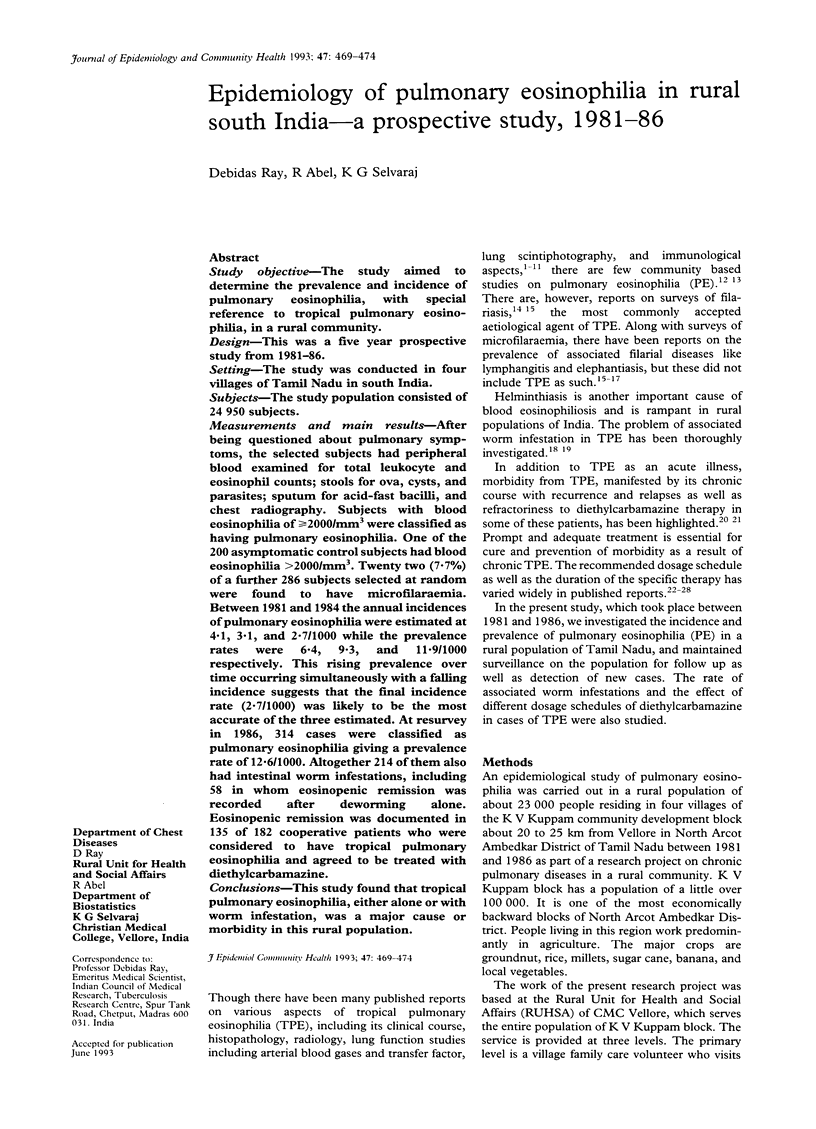

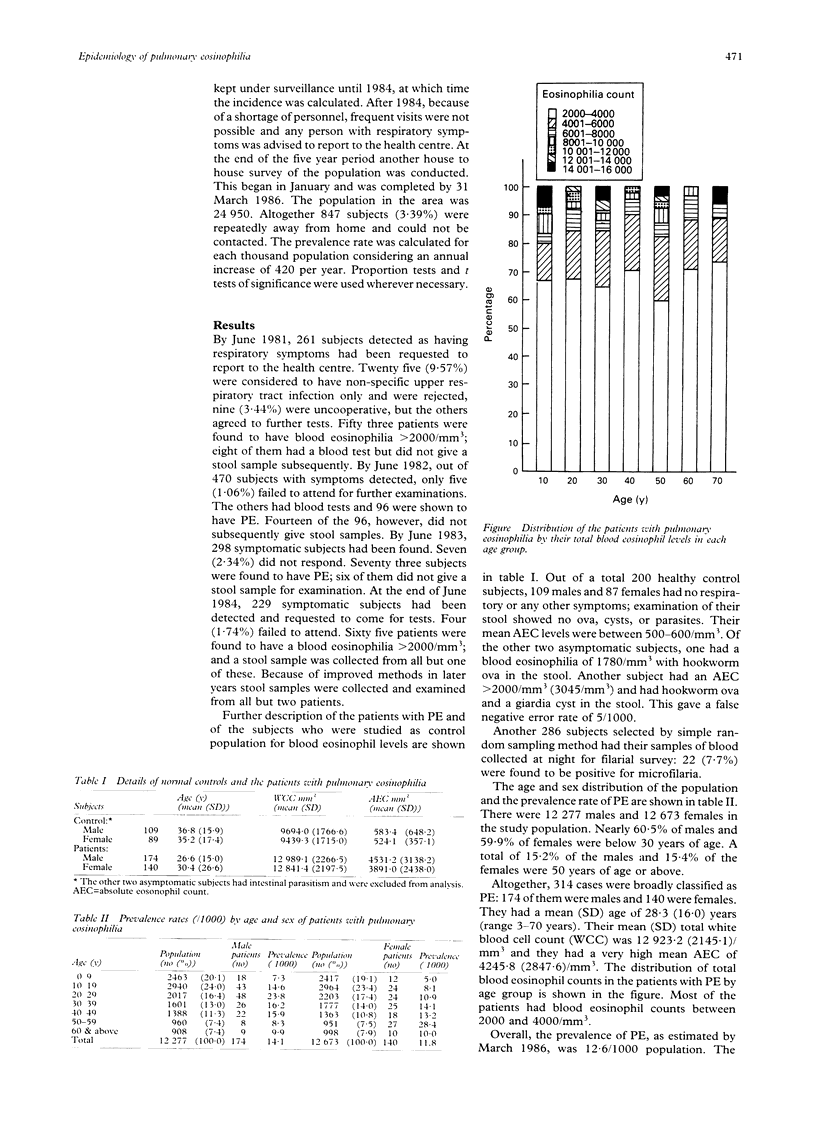
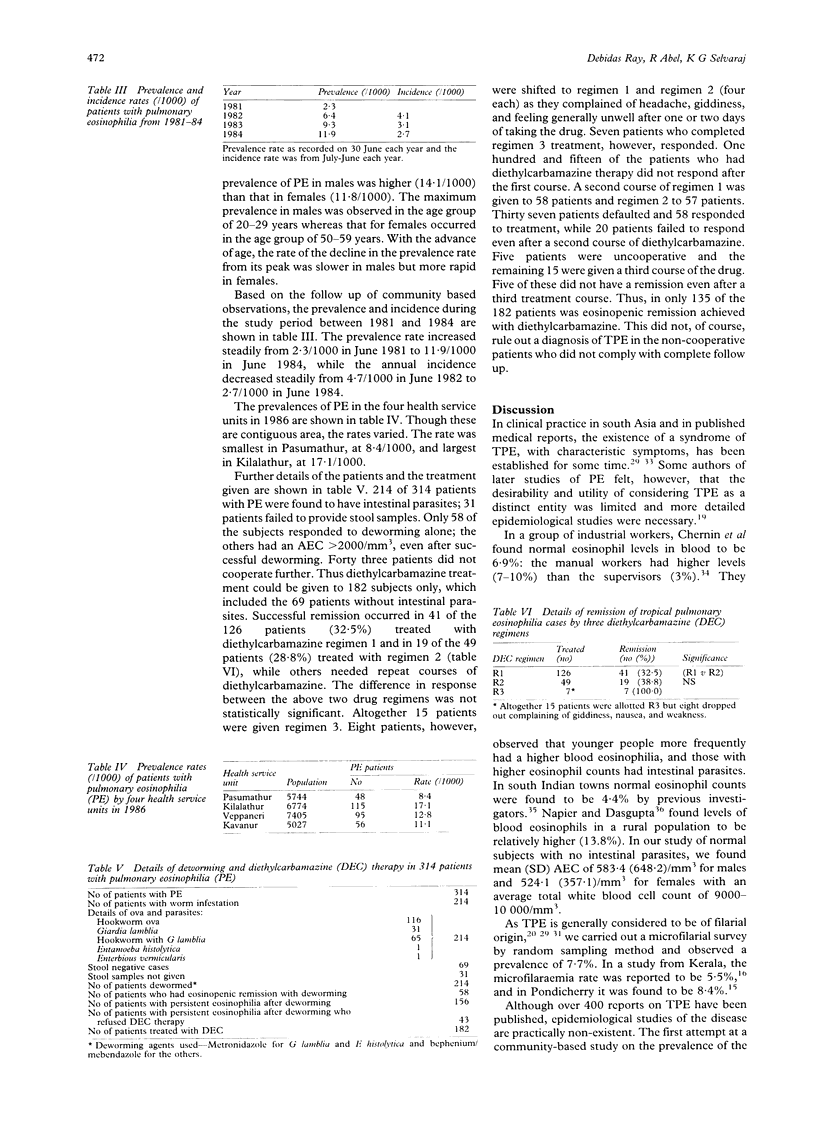
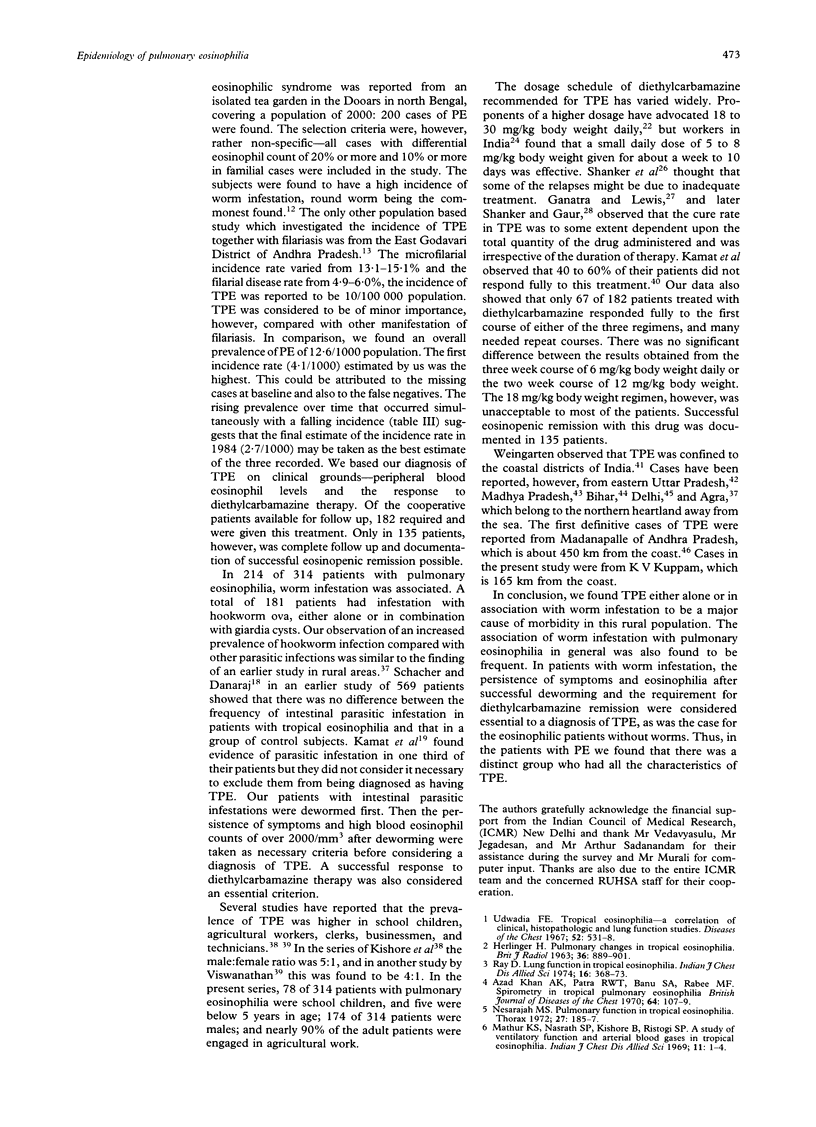
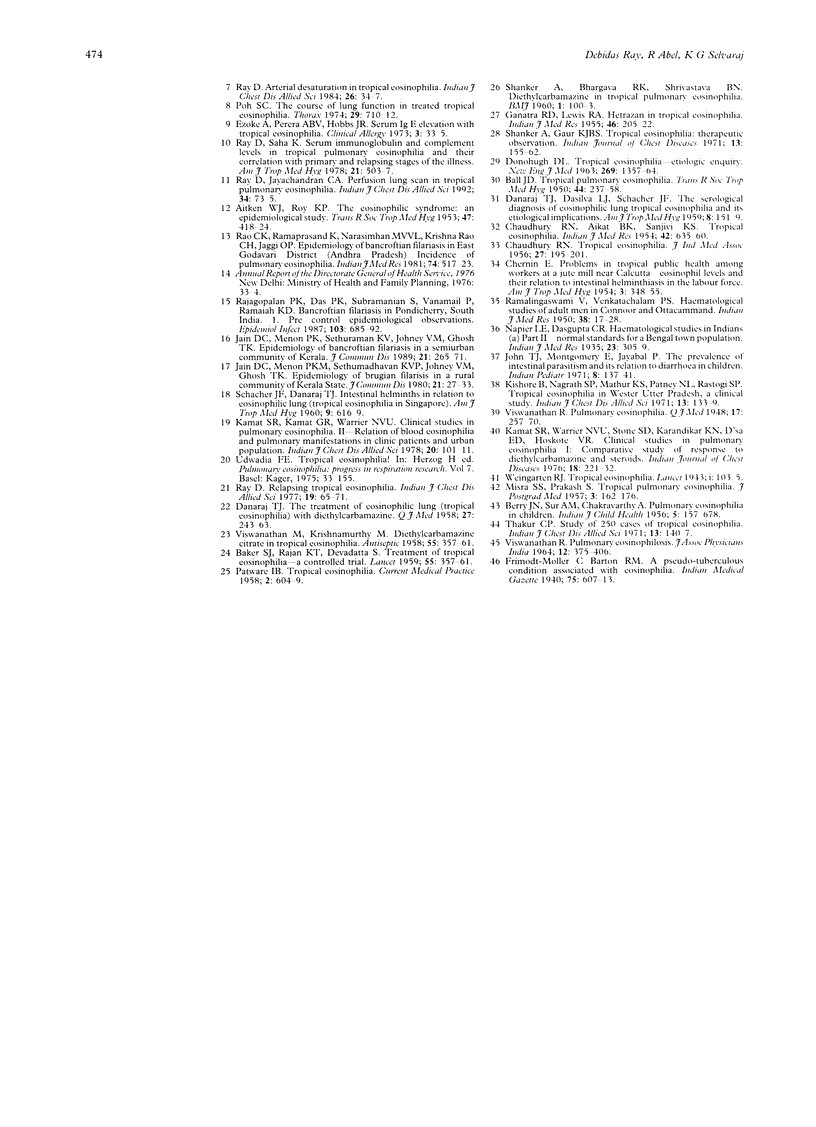
Selected References
These references are in PubMed. This may not be the complete list of references from this article.
- AITKEN W. J., ROY K. P. The eosinophilic syndrome; an epidemiological study. Trans R Soc Trop Med Hyg. 1953 Sep;47(5):418–424. doi: 10.1016/s0035-9203(53)80025-8. [DOI] [PubMed] [Google Scholar]
- Azad Khan A. K., Patra R. W., Banu S. A., Rabbee M. F. Spirometry in tropical pulmonary eosinophilia. Br J Dis Chest. 1970 Apr;64(2):107–109. doi: 10.1016/s0007-0971(70)80036-5. [DOI] [PubMed] [Google Scholar]
- HERLINGER H. PULMONARY CHANGES IN TROPICAL EOSINOPHILIA. Br J Radiol. 1963 Dec;36:889–901. doi: 10.1259/0007-1285-36-432-889. [DOI] [PubMed] [Google Scholar]
- Jain D. C., Chandrasekharan A., Sethumadhavan K. V., Johny V. M., Cherian C., Ghosh T. K. Epidemiology of brugian filariasis in a rural community of Kerala State. J Commun Dis. 1989 Mar;21(1):27–33. [PubMed] [Google Scholar]
- Jain D. C., Menon P. K., Sethumadhavan K. V., Johney V. M., Ghosh T. K. Epidemiology of bancroftian filariasis in a semi-urban community of Kerala State. J Commun Dis. 1989 Dec;21(4):265–271. [PubMed] [Google Scholar]
- Mathur K. S., Nagrath S. P., Kishore B., Rastogi S. P. A study of ventilatory functions and arterial blood gases in tropical eosinophilia. Indian J Chest Dis. 1969 Jan;11(1):1–4. [PubMed] [Google Scholar]
- Nesarajah M. S. Pulmonary function in tropical eosinophilia. Thorax. 1972 Mar;27(2):185–187. doi: 10.1136/thx.27.2.185. [DOI] [PMC free article] [PubMed] [Google Scholar]
- Rajagopalan P. K., Das P. K., Subramanian S., Vanamail P., Ramaiah K. D. Bancroftian filariasis in Pondicherry, south India: 1. Pre-control epidemiological observations. Epidemiol Infect. 1989 Dec;103(3):685–692. doi: 10.1017/s0950268800031083. [DOI] [PMC free article] [PubMed] [Google Scholar]
- Rao C. K., Ramaprasad K., Narasimham M. V., Rao C. K., Jaggi O. P. Epidemiology of bancroftian filariasis in East Godavari district (Andhra Pradesh)--incidence of tropical pulmonary eosinophilia. Indian J Med Res. 1981 Oct;74:517–523. [PubMed] [Google Scholar]
- Ray D. Lung function in tropical eosinophilia. Indian J Chest Dis. 1974 Oct;16(4):368–373. [PubMed] [Google Scholar]
- Ray D. Relapsing tropical eosinophilia. Indian J Chest Dis Allied Sci. 1977 Apr;19(2):65–71. [PubMed] [Google Scholar]
- SCHACHER J. F., DANARAJ T. J. Intestinal helminths in relation to eosinophilic lung (tropical eosinophilia) in Singapore. Am J Trop Med Hyg. 1960 Nov;9:616–619. doi: 10.4269/ajtmh.1960.9.616. [DOI] [PubMed] [Google Scholar]
- Udwadia F. E. Tropical eosinophilia. A correlation of clinical, histopathologic and lung function studies. Dis Chest. 1967 Oct;52(4):531–538. doi: 10.1378/chest.52.4.531. [DOI] [PubMed] [Google Scholar]


